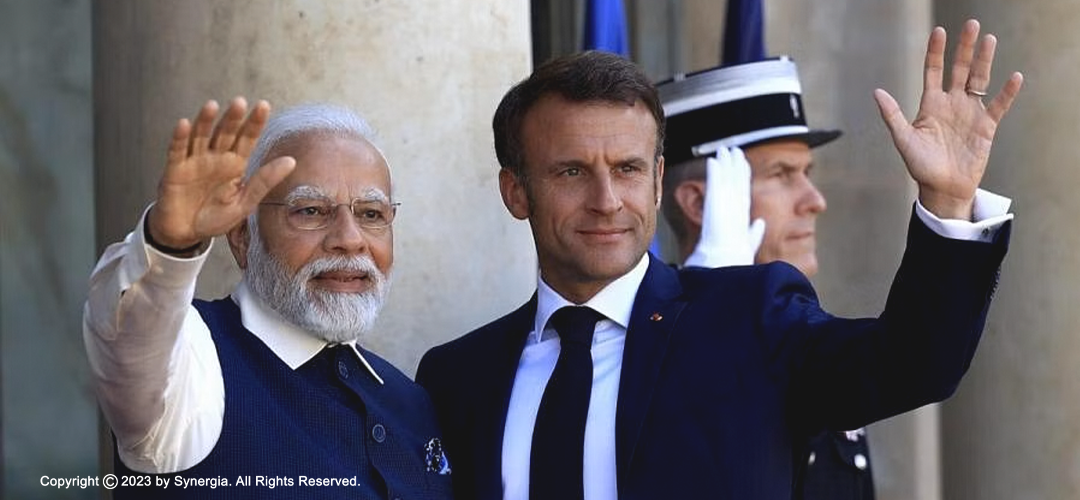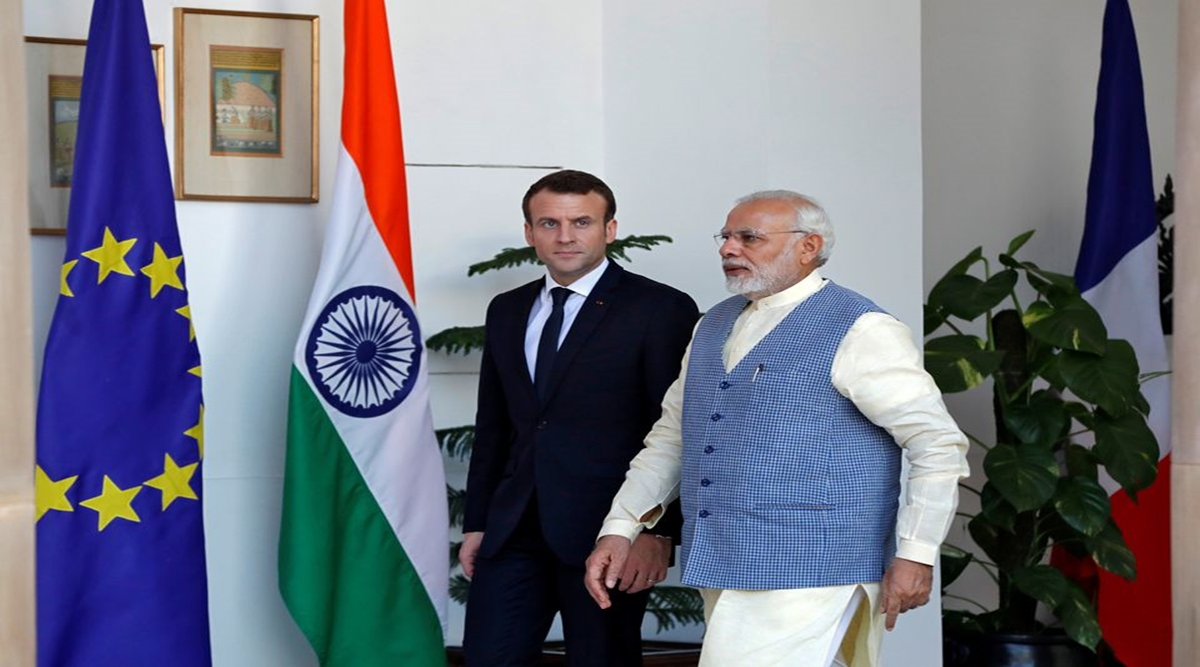Going From Strength to Strength
July 22, 2023 | Expert Insights

Coming on the heels of a highly successful and high-profile visit to the U.S., Prime Minister Modi's France sojourn may have lacked the glitter but was no less significant. As an Indian Tri-service contingent marched smartly down the Champs-Elysees impeccably in unison, a visibly proud Indian Prime Minister greeted them from the Presidential enclosure. It was indeed a landmark event in the long-sustaining Indo-French relations.
Background
India and France have historic linkages. The British effectively thwarted French efforts to colonise India, and only the widely separated enclaves of Pondicherry, Karaikal, Mahe and Yanam Royal Navy survived till 1963, when they were peacefully absorbed into the Union of India.
The subcontinent was always important to French calculations. This was both as an opponent and later on as an ally of the British Empire. The few possessions that the French had in India ensured that some French influence spread in the country.
When India became independent, France established diplomatic relations with New Delhi without delay. The French territories in India were handed over to the new government through negotiations. But relations could not take off immediately. France became a part of the NATO alliance, while India followed a decidedly non-aligned policy in the emerging Cold War.
France always wanted to differentiate itself from the Anglo-American bloc within the Western alliance. It considered itself to be a post-imperialist power with a difference. Only after the end of the Cold War did it get an opportunity to engage substantially with India. When India conducted its nuclear tests in 1998, the Western world condemned New Delhi. The only exception to this was France, who stood by India's side. The Indian people never forgot this. This was the beginning of the blossoming of the Indo-French relationship.

Analysis
This visit by Prime Minister Modi is a game changer in more ways than one. The aim on both sides has been to take this relationship to the next level. Diversification has been the catchword. Until now, the focus has been on the military/security sphere. But France offers India much more opportunity than that and vice-versa. This visit has tried to correct this anomaly while at the same time ensuring that interaction in the security sphere becomes more meaningful in nature.
First, in the area of defence, there has been substantial progress. Earlier, this defence relationship was mostly one-sided. France supplied the weapons systems which India would use. The most striking example of this is the French Rafale fighter jets which follow a chain of fighter aircraft ranging from the Ouragans (Toofani) in 1953, the Mystere in 1957 and the Mirage 2000 in the 1980s (which performed superlatively in the Kargil war). However, this vendor-buyer transaction was no different from the one that India had with other big powers. There had to be a greater level of collaboration to increase trust between the two sides.
This has been achieved during this visit. The supplier-client relationship between India and France is coming to an end. Instead, a partnership of equals has been initiated. Joint co-production is the pillar of this new partnership. From now on, DRDO will work with its French counterpart Safran to co-develop jet engines for advanced medium combat aircraft. Apart from this, Safran will also develop engines for muti-role helicopters with Hindustan Aeronautics Limited.
In the naval sphere, the focus has been on submarines. This gives a navy a key advantage over its rivals. India needs upgraded submarines with the latest technology to have an edge in naval warfare, especially given the greater Chinese naval presence in the Indian Ocean. India and France have decided to jointly manufacture submarines as a sequel to the ongoing submarine production of Franco-Spanish Scorpene submarines at the Mazagaon Dock Shipbuilders.
Three documents have been signed during this visit. First is the joint communique. Second is the Horizon 2047 roadmap. And finally, there is a list of specific proposals which have been put forward and accepted by each side.
The first is just an official diplomatic statement reaffirming ties between the two countries. The second part is the most crucial. It takes a long-term view of the Indo-French relationship. A vision has been forecasted on how India and France will look at each other in 2047. And after stating this vision, the document has gone backwards to find out how this vision can be achieved within the given timeframe.
2047 is the year that India will complete 100 years of its independence. Hence this is a major milestone on the basis of which a number of targets can be set. Three key areas have been stressed in this future timeline. These are regional and international security, protection of the planet and enhancement of people-to-people contacts. India and France have something to contribute to each of these areas.
One aspect of security cooperation is armaments. There is also another side. This is in mapping the current and future geo-strategic threat environment and acting accordingly. India and France are situated in totally different geographical environments. For most of history, it was not possible for their security threats to be the same. But this has now changed. France is one of the few mainland European countries, which is also an Indo-Pacific power. This is where Indian and French geo-strategic interests converge today in a big way. France has substantial holdings in the Indo-Pacific. This includes the islands of La Reunion, New Caledonia and French Polynesia. Apart from this, it has an extensive Exclusive Economic Zone in this region along with military bases.
All this is to India’s advantage. The Indo-Pacific is India’s near maritime neighbourhood. It already has the Quad backing it up here. Adding France to this mix will only be further beneficial.
The French share the same concerns about the Indo-Pacific as India. They, too, do not want to get caught up in any US-China confrontation in this area. Like any other country, it wants the free movement of maritime transport in this vast area. France does not want to depend on the Anglo-American powers for this purpose. India with a large maritime coastline is ideally suited to partner with France in the Indo-Pacific. The possibilities here are endless. India can use French military bases. Naval collaboration can be increased further.
In the non-military sphere, climate change is a significant concern for Paris and New Delhi. Here again, India and France are in quite different situations. France is a developed, industrialised country. It has already released a substantial portion of its historic emissions. On the other hand, the industrialisation process still continues in India. Despite this, both countries share the eventual final goal of a net zero-carbon global economy. Each country has much to offer the other in this regard. France is a pioneer in civil nuclear energy. It is already assisting India in setting up new civil nuclear plants. India is moving ahead with solar energy. Here it can offer expertise to France.
One area where this relationship can improve is trade. French companies are present in India. But there is scope for further expansion. The French language is finding increasing favour in India. This will improve people-to-people contacts. During his visit, PM Modi described the ties between the two countries as "being in excellent shape" and that they are "strong, trusted, consistent".
Critical technologies will determine the future of the world. Franco-Indian cooperation is critical here. These include supercomputing, cloud computing, artificial intelligence, and quantum technologies.
France strongly believes in a multi-polar world. In this context, it has sought the reform of the United Nations Security Council and India's eventual membership in it. Having a Western country and a permanent member of the Security Council support India’s membership in this body is a huge plus for India.
Mr Modi tweeted after the visit, “We reviewed the full range of India –France relations. I am particularly enthusiastic about deepening cooperation in futuristic sectors like green hydrogen, renewable energy, AI, semiconductors and more.” If the plans envisaged above are fulfilled, then is just the beginning of a long journey of Indo-French bonhomie.
Assessment
- By looking more closely towards France, India is ensuring that it does not place all its eggs in the Anglo-American basket. India is also seeking closer engagement with the EU. As Indo-French relations move forward, this will also have an add-on beneficial effect on Indo-EU relations.
- France also wants to diversify its relationships. It wants to move away from its traditional former colonies and its continental European powers to countries that can help it shape its future. Here India is ideally suited to match France’s requirements.
- The only barrier in Indo-French relations is linguistic and cultural differences. However, as the French language and culture make further inroads into India, this will change.








Comments